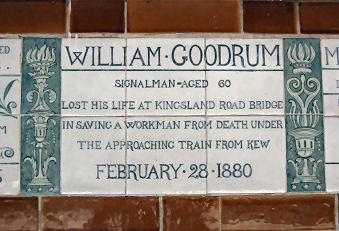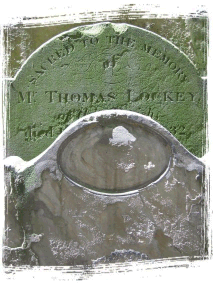
The Victorian City
Recently discovering that many of my
Victorian relatives lived in many of the squalid wens
that I'd read about in novels and history books inspired the creation of this
page.
  H. Dignall Postman's Park & the Watts Memorial of Heroic Deeds The Watts Gallery 2005 One of my favourite odd crannies in the City is Postman's Park, between the old Post Office HQ and St Botolph Aldersgate. It's gets its name from being the favoured lunching spot of Post Office workers and its charm from a wall of ceramic tablets commemorating Heroic Self Sacrifice (that's one above). It also has some finely weathered old gravestones from when it used to be a churchyard and two burial grounds. The tile tablets were the idea and creation of Victorian painter and sculptor G. F. Watts. They commemorate acts of bravery that lead to the death of the perpetrator, retold in tasteful text and quirky detail. This informative little book, first self-published in 1987, has been updated and published by The Watts Gallery, the memorial museum to that admirable chap in Surrey.
|
||
|
|
|
|
|
|
Hallie Rubenhold The Five: The Untold Lives of the Women Killed by Jack the Ripper The author has long been a friend of this site, even taking the Venice Questions in 2011, after I reviewed the first Henrietta Lightfoot novel. Around that time she mentioned that she was working on a book about Jack the Ripper's victims and I remembered being disappointed. But of course she was setting out to produce a corrective to the mainstream misogynist tourist-fleecing agenda, and the tours which make most sensitive Londoners shudder with shame. Her revisionist take has been so effective she has suffered online trolls and Daily Mail boneheads who cannot come to terms with the Ripper's victims not being prostitutes, which in their poisonous worldview means that they deserve no sympathy. The chapters here devoted to the lives of each victim. Mostly their hard but stable lives were shattered by circumstances, and they took to the bottle. A couple of them were indeed 'on the game', but one of these arguably, and the rest were not, this 'fact' being the invention of the newspapers to generate sensation and sales. Given that the original court records have been lost the writing of this book seems to have involved, apart from much fresh research, the careful interpreting and comparing of these sensationalist newspaper reports. Each life also gets a fascinating variety of background, from Peabody Trust housing, through charity schooling and the Crystal Palace to the grim details of 19th-century prostitution. The author's way with words makes this a smooth read, if not exactly an easy one, given the issues it raises, which given the toxic reaction to its compassionate standpoint cannot be dismissed as merely outdated Victorian values. The photo left is of Mitre Square in Aldgate, where the body of Catherine Eddowes, the fourth victim, was found. |
|
|
|
|